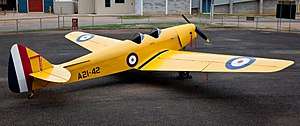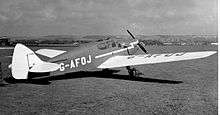de Havilland Moth Minor
The de Havilland DH.94 Moth Minor was a 1930s British two-seat tourer/trainer aircraft built by de Havilland at Hatfield Aerodrome, England and by de Havilland Australia at Bankstown Aerodrome, Australia.
| DH.94 Moth Minor | |
|---|---|
 | |
| An ex-RAAF DH.94 Moth Minor at the Benalla Aviation Museum in June 2012 | |
| Role | Tourer/Trainer |
| Manufacturer | de Havilland |
| Designer | J.P. Smith |
| First flight | 22 June 1937 |
| Number built | c.140 |
| Unit cost |
£575 |
Design and development

The Moth Minor was designed as a low-wing monoplane to replace the biplane Moth series, and was intended to give similar performance with less power, and without the need for rigging of the biplane's tensioners and struts. Its predecessor was the DH.81 Swallow Moth monoplane of 1931, of which only one was built. The wooden prototype of the DH.94 was first flown by Geoffrey de Havilland on 22 June 1937 at Hatfield Aerodrome.[1] Production started and nearly 100 examples had been built by the outbreak of the Second World War. With a selling price of only £575[1] the Moth Minor was popular with flying clubs keen to acquire modern monoplanes. Nine aircraft were specially built with hinged coupe tops instead of the normally open cockpit.
As the factory at Hatfield was needed for the war effort, the drawings, jigs, components and unfinished aircraft were shipped to the de Havilland factory at Bankstown, Sydney. More than 40 aircraft were produced in Australia.[1]
Civil aircraft operated in the United Kingdom were commandeered for use by the Royal Air Force and Fleet Air Arm, and one example was used by the United States Army Air Corps. A large number of civil aircraft from the UK were sent to Australia, where they and a handful of locally built Australian civil aircraft were commandeered by the Royal Australian Air Force.[2]
After the Second World War several Moth Minors continued to be flown by private owners in the United Kingdom.
During World War two, de Havillands took over the small grass airfield at Witney (Oxfordshire) where they operated as a Civilian Repair Organisation on behalf of the British Government. They carried out complete overhauls to battle-damaged Spitfires and Hurricanes, plus any de Havilland types. An ex-Battle of Britain RAF pilot had been posted in to Witney to carry out the test flights as the aircraft were completed by the factory but as the war drew to an end, he was de-mobbed and test-flights carried out by de Havilland pilots who flew down to Witney from Hatfield. Frequently, Peter de Havilland would fly in to Witney in a DH.94 Moth Minor which was the coupe model and had a variable-pitch airscrew.
Variants
- DH.94 Moth Minor : Two-seat touring and training aircraft.
- Moth Minor Coupe : Two-seat touring and training aircraft, with a built-up rear fuselage and hinged cabin top.
Operators
Specifications
Data from British Civil Aircraft since 1919, Vol 2 [1]
General characteristics
- Crew: 2
- Length: 24 ft 5 in (7.44 m)
- Wingspan: 36 ft 7 in (11.15 m)
- Height: 6 ft 4 in (1.93 m)
- Wing area: 162 sq ft (15.1 m2)
- Airfoil: RAF34 modified[3]
- Empty weight: 983 lb (446 kg)
- Max takeoff weight: 1,550 lb (703 kg)
- Powerplant: 1 × de Havilland Gipsy Minor 4-cylinder inverted air-cooled in-line piston engine, 90 hp (67 kW)
- Propellers: 2-bladed fixed-pitch wooden propeller
Performance
- Maximum speed: 118 mph (190 km/h, 103 kn)
- Cruise speed: 100 mph (160 km/h, 87 kn)
- Range: 300 mi (480 km, 260 nmi)
- Service ceiling: 16,500 ft (5,000 m)
- Rate of climb: 620 ft/min (3.1 m/s)
- Wing loading: 9.57 lb/sq ft (46.7 kg/m2)
- Power/mass: 0.58 hp/lb (0.95 kW/kg)
Surviving aircraft
A number of Moth Minors have survived, including:
Australia
- VH-AAM C/N 94002, dismantled remains stored in Albury, New South Wales, as a possible restoration project.[4]
- VH-AGO ex RAAF A21-14 ex G-AFOR C/N 9404, still airworthy, owned by Charles Camilleri, New South Wales, Australia.[5]
- VH-AIB ex RAAF A21-38 C/N DHP17, still airworthy, owned by Steve Jenkins and located at Goolwa, South Australia.[6][7][8][9]
- VH-CZB ex RAAF A21-42 C/N 94067, still airworthy, owned by Mark Carr and located at the Benalla Aviation Museum, Vic.[6][10][11][12]
- VH-THT ex RAAF A21-12 C/N 94076, preserved and on display at the Royal Australian Air Force Association of Western Australia's Aviation Heritage Museum, Bull Creek, Perth, Western Australia.[13]
New Zealand
- ZK-AKM ex RNZAF NZ597 ex ZK-AHK ex G-AFON C/N 94012, airworthy, owned by Stan Smith of Albany, Auckland.[14]
USA
- N94DH ex HB-OMU C/N 94020, currently stored with the Commemorative Air Force, previously operated by the Rio Grande Valley Wing and painted in spurious RAF markings.[15] In 2016, the CAF listed N94DH as a restoration candidate available for reassignment to another wing.[16]
- N9403 ex ZK-BFP ex G-AFRR ex RAF HM579 ex G-AFRR C/N 9403, airworthy with Magerko Management LLC at Bandel Airport, Glyde, Pennsylvania.[17]
See also
Aircraft of comparable role, configuration and era
Related lists
References
Notes
- Jackson, A.J. (1973). British Civil Aircraft since 1919 Volume 2. London: Putnam. ISBN 0-370-10010-7.
- ADF Serials list of RAAF Moth Minors. Retrieved: 11 December 2008
- Lednicer, David. "The Incomplete Guide to Airfoil Usage". m-selig.ae.illinois.edu. Retrieved 16 April 2019.
- https://abpic.co.uk/pictures/view/1454909
- http://www.airport-data.com/aircraft/VH-AGO.html
- ADF Serials list of RAAF Moth Minors. Retrieved: 16 June 2012
- Clyde North Aeronautical Preservation Group. Archived 4 March 2016 at the Wayback Machine Retrieved: 16 June 2012
- Airliners.net. Retrieved: 16 June 2012
- Ed Coates Aircraft Photographs. Retrieved: 16 June 2012
- Adventure Flights Benalla – List of Aircraft Retrieved: 16 June 2012
- Australian Warbirds. Archived 2012-03-17 at the Wayback Machine Retrieved: 16 June 2012
- Airliners.net. Retrieved: 16 June 2012
- http://www.raafawa.org.au/museum/moth-minor#!moth_minor_1_160
- http://www.airport-data.com/aircraft/ZK-AKM.html
- http://www.aerialvisuals.ca/AirframeDossier.php?Serial=3106
- https://commemorativeairforce.org/safety-aircraft-maintenance/safety-operations-and-maintenance-blog/entry/caf-aircraft-available-for-assignment
- http://www.aerialvisuals.ca/AirframeDossier.php?Serial=13372
- http://www.airport-data.com/aircraft/G-AFPN.html
- http://www.johnsshawaviation.co.uk/wordpress/sample-page/
- http://www.airport-data.com/aircraft/G-AFRR.html
Bibliography
- The Illustrated Encyclopedia of Aircraft (Part Work 1982–1985). Orbis Publishing.
- "Moth Successor: The New Moth Minor Described" Flight 1939
External links
| Wikimedia Commons has media related to De Havilland DH.94 Moth Minor. |